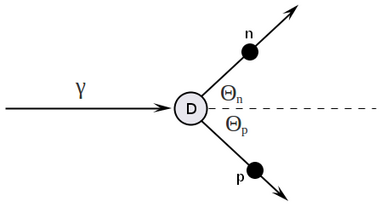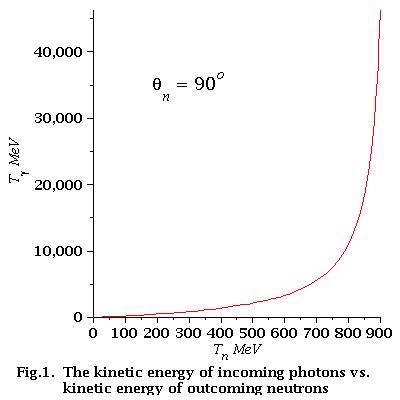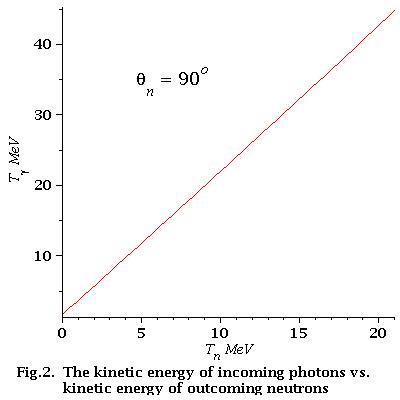Difference between revisions of "Neutron Polarimeter"
| Line 37: | Line 37: | ||
| − | For non-relativistic neutrons <math>T_n \ll m_n = 939.5\ MeV</math> and the formula above is | + | For non-relativistic neutrons <math>T_n \ll m_n = 939.5\ MeV</math> and the formula above is become: |
<math>T_{\gamma} = \frac {m_p^2 - m_n^2 - m_D^2 + 2\ m_D m_n + 2\ m_D T_n}{2\ (m_D - m_n)} </math> | <math>T_{\gamma} = \frac {m_p^2 - m_n^2 - m_D^2 + 2\ m_D m_n + 2\ m_D T_n}{2\ (m_D - m_n)} </math> | ||
Revision as of 18:39, 5 April 2011
Four-vector Algebra
Let's do the four-vector algebra:
By conservation of four-momentum:
Squaring both side of equation above and using the four-momentum invariants we have:
Detector located at case
Detector is located at , and the formula above is simplified:
We can easily solve the equation above with respect to incident photon energy:
For non-relativistic neutrons and the formula above is become:
Substituting the corresponding masses, we get finally:
and visa versa:
Here I derived the formula [2] just inversing the formula [1]. I can as well start from exact solution above, solve this equation with respect to neutron energy, do the non-relativistic approximation and get exactly the same formula [2]. But anyway we ended up with two useful non-relativistic formulas we can analyze now.
Using the formulas above we can:
1. Predict the threshold of reaction:
2. Predict the incident photon energy based on the detected neutron energy.
3. Predict the detected neutron energy based on the incident photon energy.
- for the incident photons up to 25 MeV we have (0 - 11.69) MeV neutrons
- for the incident photons up to 44 MeV we have (0 - 21.17) MeV neutrons
Also note:
and visa versa
how it looks
low energy approximation=
As we can see from Fig.2 for low energy neutrons (0-21 MeV)
energy dependence of incident photons is linear
Find that dependence. We have:
So, the equation of the line is:
Finally for low energy neutrons (0-21 MeV):
example of error calculation
example 1
Say, we have, 10 MeV neutron with uncertainty 1 MeV, the corresponding uncertainly for photons energy is:
example 2
Say, the neutron's time of flight uncertainly is 1 ns
The neutron's kinetic energy is:
And:
Also we need the neutron's time of flight as function of neutron's kinetic energy:
Say, we have 10 MeV neutron, 1 m away detector, and neutron's time of flight uncertainty is 1 ns. Then the neutron time of flight is:
Neutron kinetic energy errors are:
And photon energy errors are:
Below are some examples for different detector distance and neutron kinetic energy:
| 1 ns | 1 m | 5 MeV | 0.103 | 32 ns | 0.31 MeV | 6.2 % | 0.64 MeV | 5.3 % |
| 1 ns | 1 m | 10 MeV | 0.145 | 23 ns | 0.88 MeV | 8.8 % | 1.81 MeV | 8.1 % |
| 1 ns | 1 m | 20 MeV | 0.203 | 16 ns | 2.51 MeV | 12.6 % | 5.16 MeV | 12.1 % |
| 1 ns | 1 m | 0.5 MeV | 0.033 | 102 ns | 0.010 MeV | 1.9 % | ||
| 1 ns | 1 m | 1 MeV | 0.046 | 72 ns | 0.028 MeV | 2.8 % | ||
| 1 ns | 1 m | 2 MeV | 0.065 | 51 ns | 0.078 MeV | 3.9 % | ||
| 1 ns | 1 m | 4 MeV | 0.092 | 36 ns | 0.22 MeV | 5.5 % |


